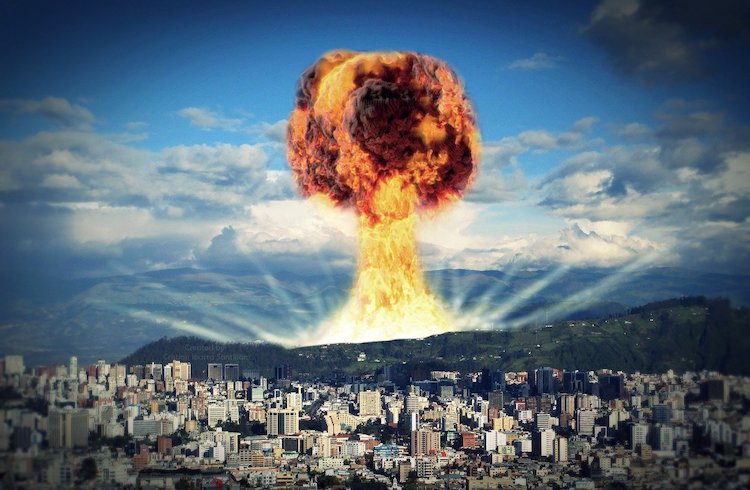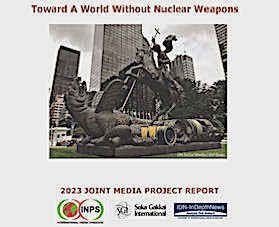By Ramesh Jaura
BERLIN 13 July 2023 (IDN) — Ahead of first session of the Preparatory Committee for the 2026 Review Conference of the Parties to the Treaty on the Non-Proliferation of Nuclear Weapons (NPT) from 31 July to 11 August 2023 in Vienna, the Global Network to Eliminate Nuclear Weapons, Abolition 2000 has warned of increasing risks of nuclear war by accident, miscalculation, crisis escalation and/or intent.
The forthcoming meeting will be the first of three planned sessions before the 2026 Review Conference. The Preparatory Committee, open to all States parties to the Treaty, is responsible for addressing substantive and procedural issues related to the Treaty and the forthcoming Review Conference. The Chair-designate of the first session is Ambassador Jarmo Viinanen of Finland.
A working paper of Abolition 2000 points to the importance of the forthcoming gathering in the aftermath of the Russian war of aggression on Ukraine—President Putin's threats to use nuclear weapons, bringing into sharp focus the compelling need for disarmament. Public tests of nuclear-capable missiles and forward deployment of atomic weapons to a neighbouring State (Belarus) demonstrate a high level of Russia's willingness to use the weapons, it says.
The Ukraine war also has demonstrated the dangers of 21st-century warfare, with its mix of missiles, missile defences, aircraft, unpiloted vehicles, ever more complex earth- and space-based sensing and communications technologies, and disruptive electronic and cyberwarfare pushing the pace and complexity of war to the limits of human comprehension, states Abolition 2000.
The Global Network to Eliminate Nuclear Weapons rightly points out that "the intensifying array of antagonisms among nuclear-armed governments, of which the Ukraine war is just one manifestation, are accelerating a broad-spectrum multipolar arms race". Fast-developing technologies create non-nuclear capabilities of strategic significance and are incorporated into new or modernized systems for delivering nuclear weapons and defending against them.
All this has also led to the temptations and perils of applying artificial intelligence to weapons systems amidst a more general high-stakes AI technology competition.
Furthermore, the European theatre is not the only region experiencing increased tensions among nuclear-armed states. These also occur in North-East Asia, the South China Sea, South Asia and the Middle East.
Against this grim background, nuclear disarmament may appear too distant to merit much attention in a dangerous and demanding present. But controlling nuclear weapons and charting a path towards their elimination always has been a mix of incremental measures undertaken in difficult times and long-term efforts to build the elements for a nuclear-weapon-free world. Treaties to limit nuclear arms and related technologies were negotiated in the depths of the Cold War, even while nuclear-armed states were engaged in active hostilities.
The United States and the Soviet Union completed the first Strategic Arms Limitation Treaty and the Anti-Ballistic Missile Treaty (ABM Treaty) during the war in Vietnam, a war in which the USSR provided weapons and assistance to the Democratic Republic of Vietnam, including anti-aircraft systems (some with Soviet crews) that downed US aircraft.
The Nuclear Non-Proliferation Treaty, the only arms treaty that on its face requires its nuclear-armed parties to negotiate to eliminate their nuclear arsenals, entered into force for its 43 initial parties, including the nuclear-armed United States, United Kingdom, and USSR, at the height of that war in 1970.
Arms control efforts continued through the Cold War, with additional treaties completed and broader preparatory work done by governments and elements of civil society, with non-government experts and mass disarmament movements playing a substantial role.
This prepared the ground for more rapid progress when the largely unanticipated political developments that constituted “the end of the Cold War” occurred.
Negotiations, deliberations and constructive thinking
"Equally important amidst the current crisis, we learned during the Cold War that even when the prospects for tangible disarmament progress are dim, negotiations between nuclear-armed adversaries can have other positive results," Abolition 2000 argues. Negotiations allow the adversaries' military and political leadership to understand each other's intentions and fears better. They build broader communication channels between military and government bureaucracies that can be of tremendous value when tensions rise.
Even those in nuclear-armed governments at war who do not believe the time is ripe to negotiate the end of hostilities currently underway should recognize the value of talking to their adversaries at every opportunity about limiting the most dangerous of all weapons, and about assuring that they will never be used, declares the Global Network stressing 'NO NUKES. NO WAR.'
No fruitful goal can be achieved by any government if its people and the means to sustain them do not survive. And no government has the right to put the existence of its people, or any other people, at risk merely to assure the government's political survival," a point that is often ignored by those who plead for insist on more and more weapons to Ukraine to enable it "defend its territory and integrity" against the Russian aggression.
"Thinking about how to prevent the use of nuclear weapons in the present and how to eliminate them are complementary efforts. As long as nuclear weapons exist, it will always be the right time to think concretely and constructively about how we will eliminate them forever."
The forthcoming review conference is significant. It takes place against the backdrop that the NPT entered into force in 1970 and was extended indefinitely in 1995. The Treaty is the cornerstone of the global nuclear non-proliferation regime and an essential foundation for pursuing nuclear disarmament. It was designed to prevent the spread of nuclear weapons, to further the goals of nuclear disarmament and general and complete disarmament, and to promote cooperation in the peaceful uses of nuclear energy.
Under the Treaty, the nuclear-weapon States are obliged not to transfer possession or control to any recipient nuclear weapons or other nuclear explosive devices and not in any way to assist, encourage or induce non-nuclear-weapon States to manufacture, acquire or control over such weapons or devices.
The non-nuclear-weapon States are obliged not to receive any transfer of or control over nuclear weapons or nuclear explosive devices, manufacture or otherwise acquire such weapons or devices, or not seek or receive any assistance in this regard.
The non-nuclear-weapon States further undertake to accept safeguards administered by the International Atomic Energy Agency (IAEA) on all source or special fissionable materials in all peaceful nuclear activities within their territory or under their jurisdiction or control to prevent diversion of nuclear energy from peaceful uses to nuclear weapons or other nuclear explosive devices.
The Treaty guarantees the right of all States parties to develop research, production and use of nuclear energy for peaceful purposes without discrimination and in conformity with their basic non-proliferation obligations. Article VI of the NPT includes the only legally binding treaty-based commitment requiring States to pursue effective measures related to nuclear disarmament in good faith. [IDN-InDepthNews]
Image source: Contemporary Security Policy .













